HSH702: Housing for Indigenous Australians and Health Report
VerifiedAdded on 2023/01/16
|14
|3761
|63
Report
AI Summary
This report addresses the critical relationship between housing and health for Indigenous Australians, focusing on the context of the Northern Territory. It begins by highlighting housing as a key social determinant of health, examining the structural issues, overcrowding, and substandard conditions prevalent in Indigenous communities, especially in rural areas. The report delves into the impact of poor housing on various health aspects, including physical and psychological well-being, and details the role of social determinants of health in this context. It provides evidence-based policy recommendations for the Northern Territory government, suggesting initiatives such as environmental health inspectors, a collaborative decision-making process, and the re-establishment of Indigenous-led housing groups. The recommendations emphasize the need for well-maintained housing, access to essential services, and consistent data collection to improve health outcomes and close the gap in Indigenous health disparities. The report concludes by reiterating the importance of housing in promoting health and well-being, emphasizing the need for culturally appropriate and well-maintained housing as a foundation for improved health outcomes.
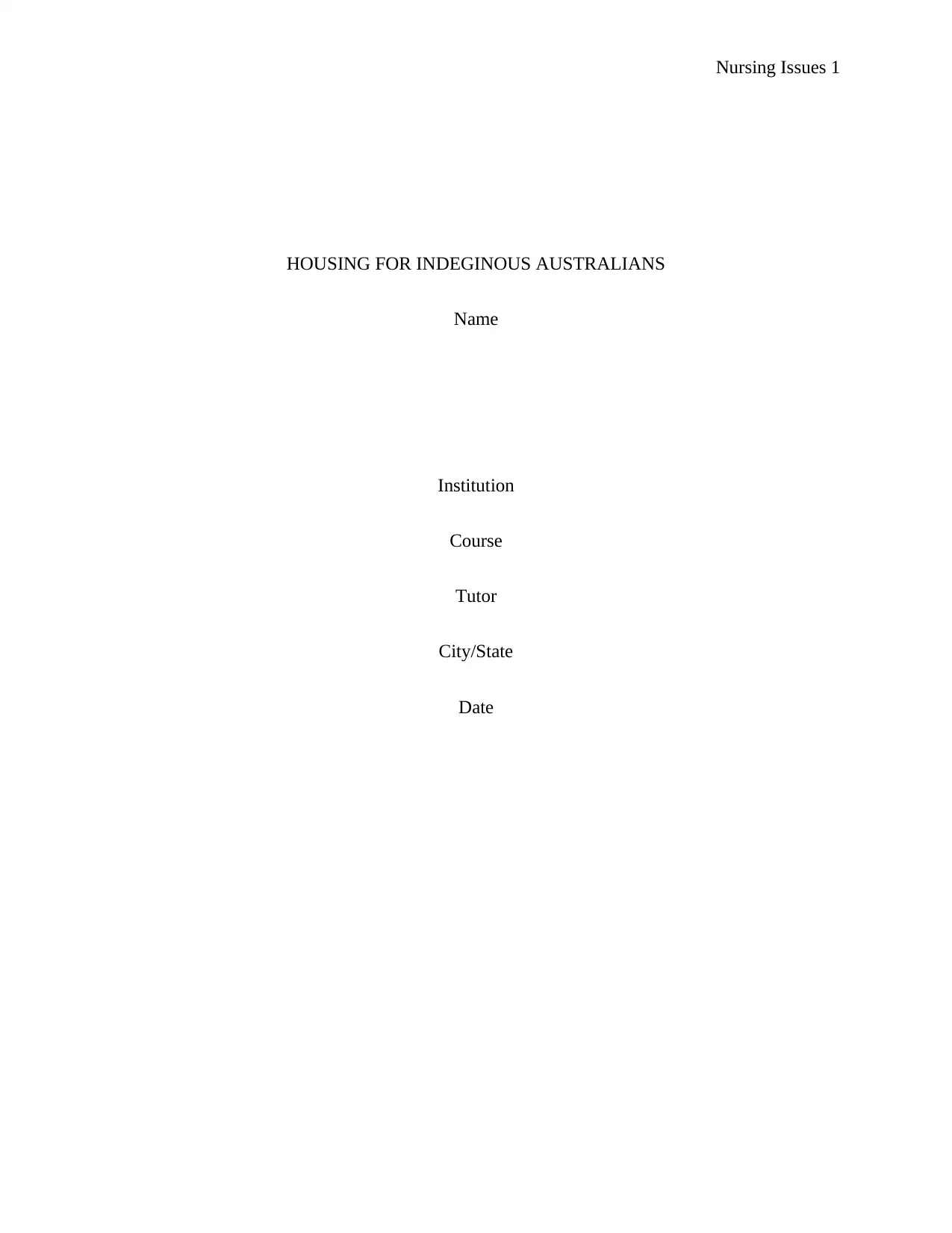
Nursing Issues 1
HOUSING FOR INDEGINOUS AUSTRALIANS
Name
Institution
Course
Tutor
City/State
Date
HOUSING FOR INDEGINOUS AUSTRALIANS
Name
Institution
Course
Tutor
City/State
Date
Paraphrase This Document
Need a fresh take? Get an instant paraphrase of this document with our AI Paraphraser
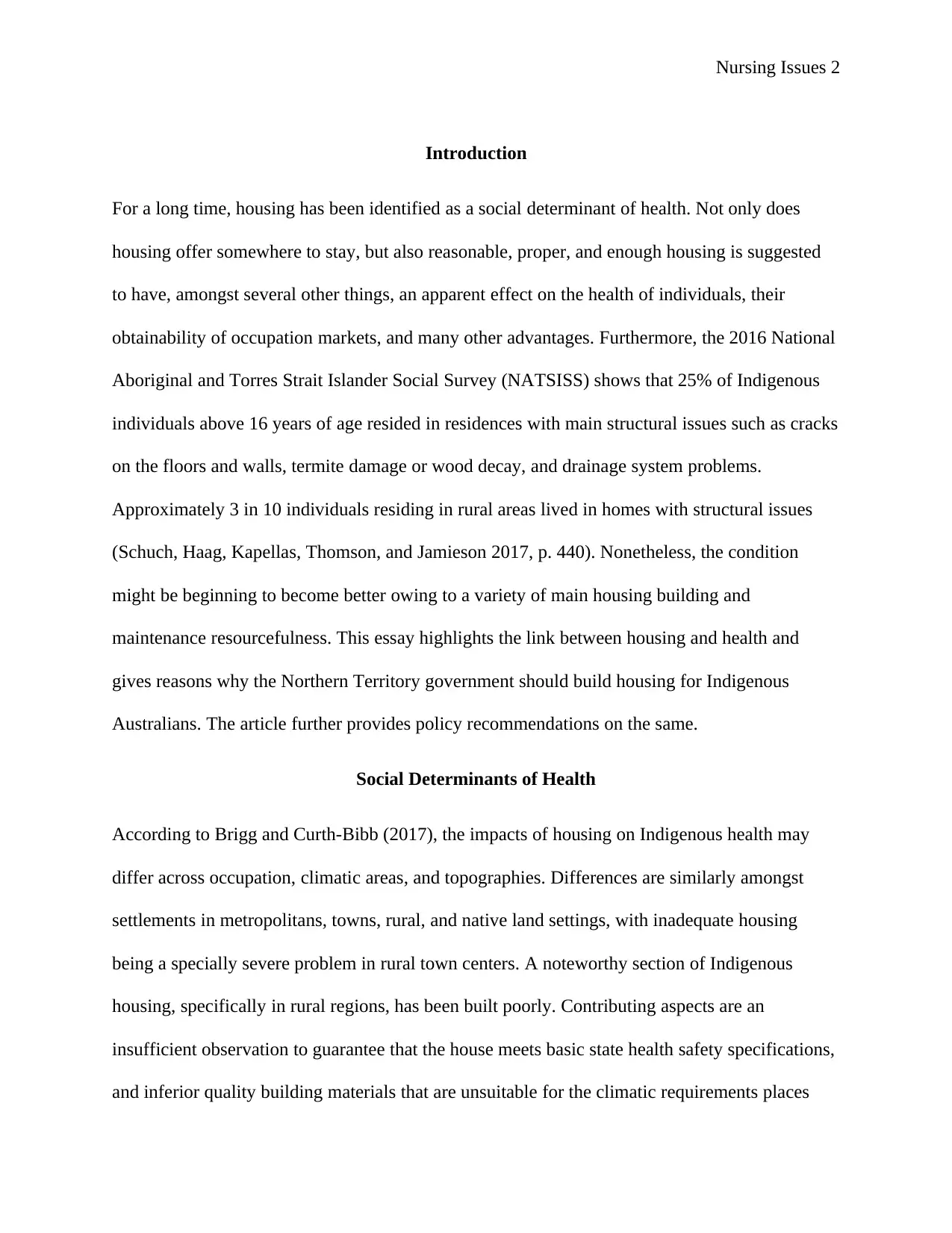
Nursing Issues 2
Introduction
For a long time, housing has been identified as a social determinant of health. Not only does
housing offer somewhere to stay, but also reasonable, proper, and enough housing is suggested
to have, amongst several other things, an apparent effect on the health of individuals, their
obtainability of occupation markets, and many other advantages. Furthermore, the 2016 National
Aboriginal and Torres Strait Islander Social Survey (NATSISS) shows that 25% of Indigenous
individuals above 16 years of age resided in residences with main structural issues such as cracks
on the floors and walls, termite damage or wood decay, and drainage system problems.
Approximately 3 in 10 individuals residing in rural areas lived in homes with structural issues
(Schuch, Haag, Kapellas, Thomson, and Jamieson 2017, p. 440). Nonetheless, the condition
might be beginning to become better owing to a variety of main housing building and
maintenance resourcefulness. This essay highlights the link between housing and health and
gives reasons why the Northern Territory government should build housing for Indigenous
Australians. The article further provides policy recommendations on the same.
Social Determinants of Health
According to Brigg and Curth-Bibb (2017), the impacts of housing on Indigenous health may
differ across occupation, climatic areas, and topographies. Differences are similarly amongst
settlements in metropolitans, towns, rural, and native land settings, with inadequate housing
being a specially severe problem in rural town centers. A noteworthy section of Indigenous
housing, specifically in rural regions, has been built poorly. Contributing aspects are an
insufficient observation to guarantee that the house meets basic state health safety specifications,
and inferior quality building materials that are unsuitable for the climatic requirements places
Introduction
For a long time, housing has been identified as a social determinant of health. Not only does
housing offer somewhere to stay, but also reasonable, proper, and enough housing is suggested
to have, amongst several other things, an apparent effect on the health of individuals, their
obtainability of occupation markets, and many other advantages. Furthermore, the 2016 National
Aboriginal and Torres Strait Islander Social Survey (NATSISS) shows that 25% of Indigenous
individuals above 16 years of age resided in residences with main structural issues such as cracks
on the floors and walls, termite damage or wood decay, and drainage system problems.
Approximately 3 in 10 individuals residing in rural areas lived in homes with structural issues
(Schuch, Haag, Kapellas, Thomson, and Jamieson 2017, p. 440). Nonetheless, the condition
might be beginning to become better owing to a variety of main housing building and
maintenance resourcefulness. This essay highlights the link between housing and health and
gives reasons why the Northern Territory government should build housing for Indigenous
Australians. The article further provides policy recommendations on the same.
Social Determinants of Health
According to Brigg and Curth-Bibb (2017), the impacts of housing on Indigenous health may
differ across occupation, climatic areas, and topographies. Differences are similarly amongst
settlements in metropolitans, towns, rural, and native land settings, with inadequate housing
being a specially severe problem in rural town centers. A noteworthy section of Indigenous
housing, specifically in rural regions, has been built poorly. Contributing aspects are an
insufficient observation to guarantee that the house meets basic state health safety specifications,
and inferior quality building materials that are unsuitable for the climatic requirements places
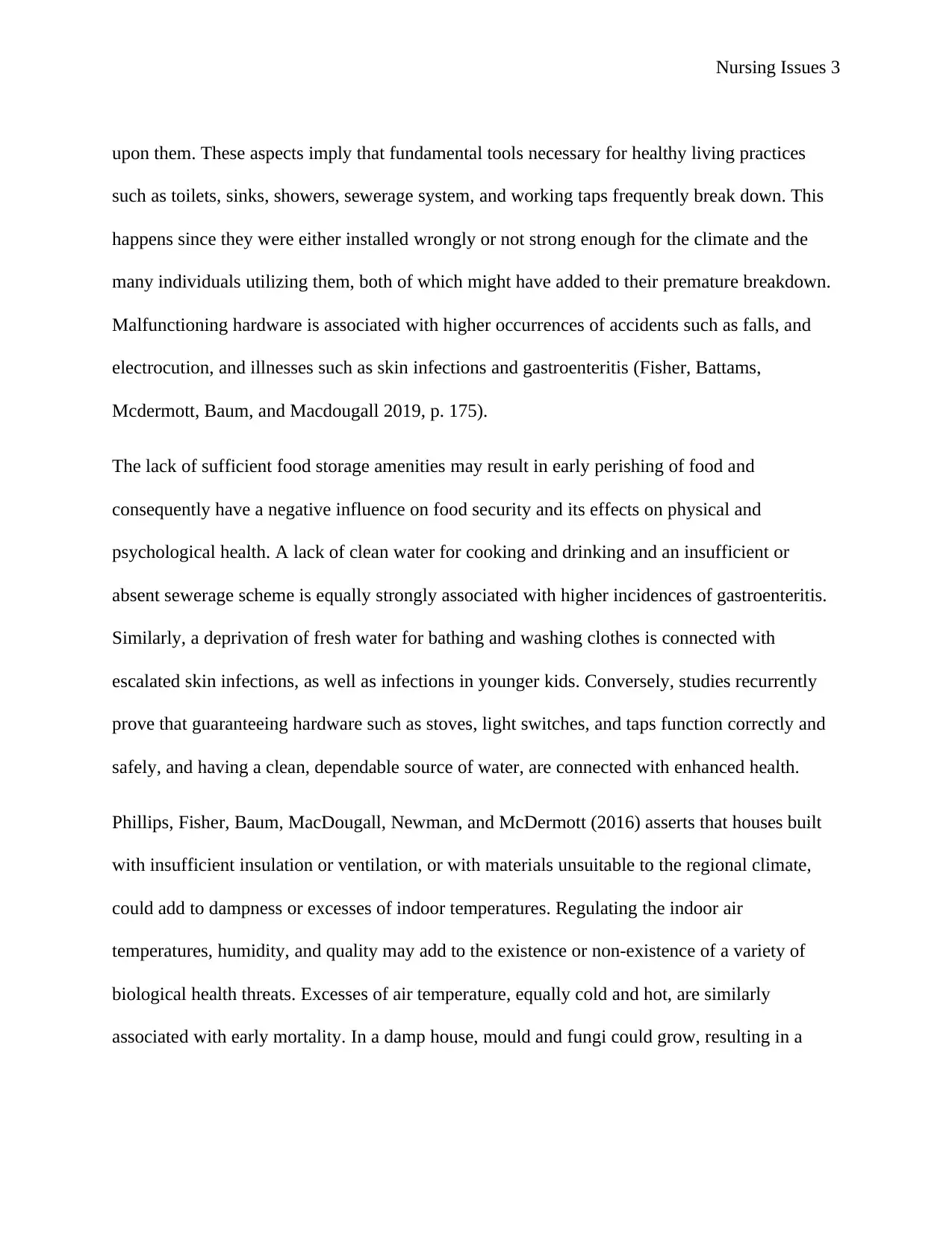
Nursing Issues 3
upon them. These aspects imply that fundamental tools necessary for healthy living practices
such as toilets, sinks, showers, sewerage system, and working taps frequently break down. This
happens since they were either installed wrongly or not strong enough for the climate and the
many individuals utilizing them, both of which might have added to their premature breakdown.
Malfunctioning hardware is associated with higher occurrences of accidents such as falls, and
electrocution, and illnesses such as skin infections and gastroenteritis (Fisher, Battams,
Mcdermott, Baum, and Macdougall 2019, p. 175).
The lack of sufficient food storage amenities may result in early perishing of food and
consequently have a negative influence on food security and its effects on physical and
psychological health. A lack of clean water for cooking and drinking and an insufficient or
absent sewerage scheme is equally strongly associated with higher incidences of gastroenteritis.
Similarly, a deprivation of fresh water for bathing and washing clothes is connected with
escalated skin infections, as well as infections in younger kids. Conversely, studies recurrently
prove that guaranteeing hardware such as stoves, light switches, and taps function correctly and
safely, and having a clean, dependable source of water, are connected with enhanced health.
Phillips, Fisher, Baum, MacDougall, Newman, and McDermott (2016) asserts that houses built
with insufficient insulation or ventilation, or with materials unsuitable to the regional climate,
could add to dampness or excesses of indoor temperatures. Regulating the indoor air
temperatures, humidity, and quality may add to the existence or non-existence of a variety of
biological health threats. Excesses of air temperature, equally cold and hot, are similarly
associated with early mortality. In a damp house, mould and fungi could grow, resulting in a
upon them. These aspects imply that fundamental tools necessary for healthy living practices
such as toilets, sinks, showers, sewerage system, and working taps frequently break down. This
happens since they were either installed wrongly or not strong enough for the climate and the
many individuals utilizing them, both of which might have added to their premature breakdown.
Malfunctioning hardware is associated with higher occurrences of accidents such as falls, and
electrocution, and illnesses such as skin infections and gastroenteritis (Fisher, Battams,
Mcdermott, Baum, and Macdougall 2019, p. 175).
The lack of sufficient food storage amenities may result in early perishing of food and
consequently have a negative influence on food security and its effects on physical and
psychological health. A lack of clean water for cooking and drinking and an insufficient or
absent sewerage scheme is equally strongly associated with higher incidences of gastroenteritis.
Similarly, a deprivation of fresh water for bathing and washing clothes is connected with
escalated skin infections, as well as infections in younger kids. Conversely, studies recurrently
prove that guaranteeing hardware such as stoves, light switches, and taps function correctly and
safely, and having a clean, dependable source of water, are connected with enhanced health.
Phillips, Fisher, Baum, MacDougall, Newman, and McDermott (2016) asserts that houses built
with insufficient insulation or ventilation, or with materials unsuitable to the regional climate,
could add to dampness or excesses of indoor temperatures. Regulating the indoor air
temperatures, humidity, and quality may add to the existence or non-existence of a variety of
biological health threats. Excesses of air temperature, equally cold and hot, are similarly
associated with early mortality. In a damp house, mould and fungi could grow, resulting in a
⊘ This is a preview!⊘
Do you want full access?
Subscribe today to unlock all pages.

Trusted by 1+ million students worldwide
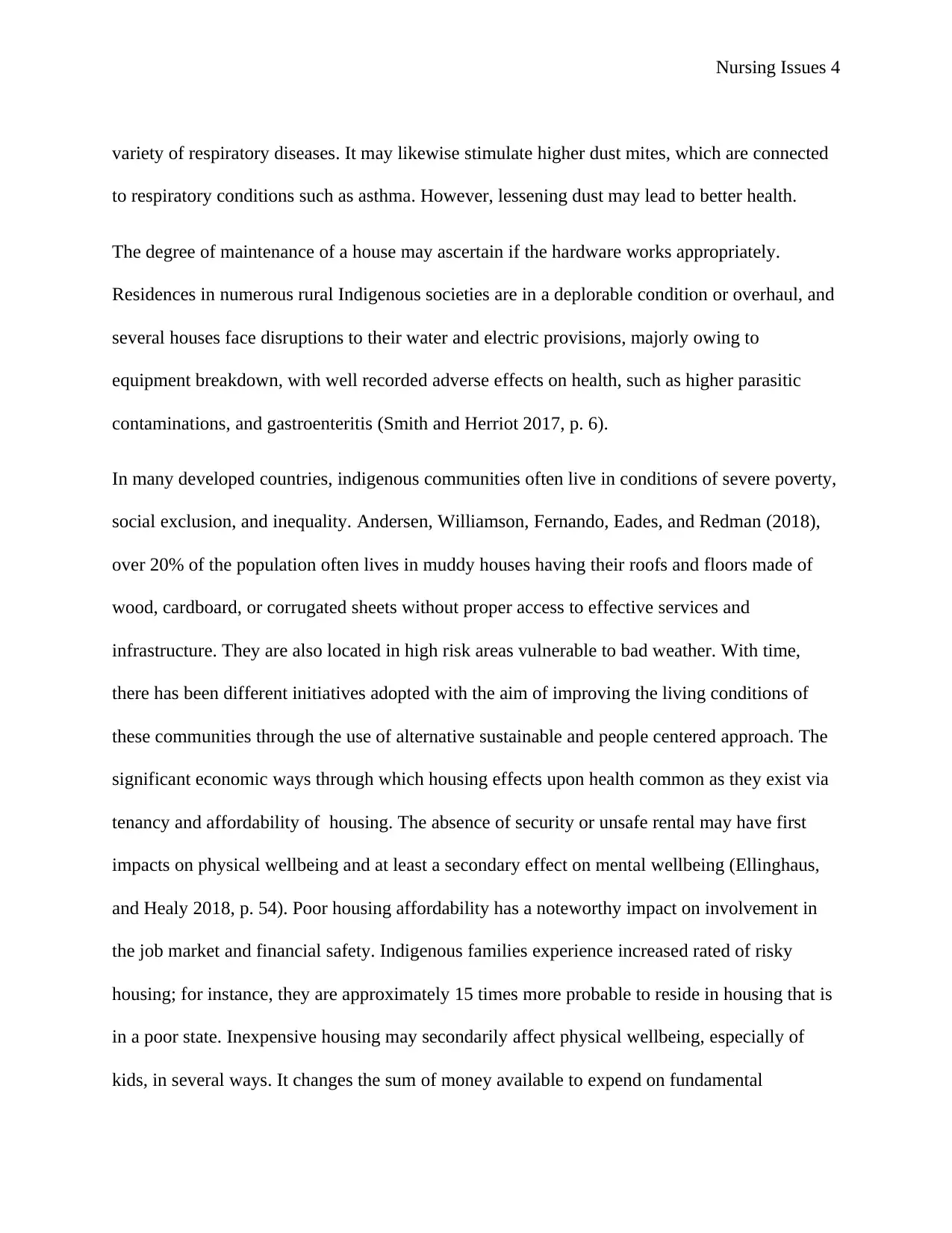
Nursing Issues 4
variety of respiratory diseases. It may likewise stimulate higher dust mites, which are connected
to respiratory conditions such as asthma. However, lessening dust may lead to better health.
The degree of maintenance of a house may ascertain if the hardware works appropriately.
Residences in numerous rural Indigenous societies are in a deplorable condition or overhaul, and
several houses face disruptions to their water and electric provisions, majorly owing to
equipment breakdown, with well recorded adverse effects on health, such as higher parasitic
contaminations, and gastroenteritis (Smith and Herriot 2017, p. 6).
In many developed countries, indigenous communities often live in conditions of severe poverty,
social exclusion, and inequality. Andersen, Williamson, Fernando, Eades, and Redman (2018),
over 20% of the population often lives in muddy houses having their roofs and floors made of
wood, cardboard, or corrugated sheets without proper access to effective services and
infrastructure. They are also located in high risk areas vulnerable to bad weather. With time,
there has been different initiatives adopted with the aim of improving the living conditions of
these communities through the use of alternative sustainable and people centered approach. The
significant economic ways through which housing effects upon health common as they exist via
tenancy and affordability of housing. The absence of security or unsafe rental may have first
impacts on physical wellbeing and at least a secondary effect on mental wellbeing (Ellinghaus,
and Healy 2018, p. 54). Poor housing affordability has a noteworthy impact on involvement in
the job market and financial safety. Indigenous families experience increased rated of risky
housing; for instance, they are approximately 15 times more probable to reside in housing that is
in a poor state. Inexpensive housing may secondarily affect physical wellbeing, especially of
kids, in several ways. It changes the sum of money available to expend on fundamental
variety of respiratory diseases. It may likewise stimulate higher dust mites, which are connected
to respiratory conditions such as asthma. However, lessening dust may lead to better health.
The degree of maintenance of a house may ascertain if the hardware works appropriately.
Residences in numerous rural Indigenous societies are in a deplorable condition or overhaul, and
several houses face disruptions to their water and electric provisions, majorly owing to
equipment breakdown, with well recorded adverse effects on health, such as higher parasitic
contaminations, and gastroenteritis (Smith and Herriot 2017, p. 6).
In many developed countries, indigenous communities often live in conditions of severe poverty,
social exclusion, and inequality. Andersen, Williamson, Fernando, Eades, and Redman (2018),
over 20% of the population often lives in muddy houses having their roofs and floors made of
wood, cardboard, or corrugated sheets without proper access to effective services and
infrastructure. They are also located in high risk areas vulnerable to bad weather. With time,
there has been different initiatives adopted with the aim of improving the living conditions of
these communities through the use of alternative sustainable and people centered approach. The
significant economic ways through which housing effects upon health common as they exist via
tenancy and affordability of housing. The absence of security or unsafe rental may have first
impacts on physical wellbeing and at least a secondary effect on mental wellbeing (Ellinghaus,
and Healy 2018, p. 54). Poor housing affordability has a noteworthy impact on involvement in
the job market and financial safety. Indigenous families experience increased rated of risky
housing; for instance, they are approximately 15 times more probable to reside in housing that is
in a poor state. Inexpensive housing may secondarily affect physical wellbeing, especially of
kids, in several ways. It changes the sum of money available to expend on fundamental
Paraphrase This Document
Need a fresh take? Get an instant paraphrase of this document with our AI Paraphraser
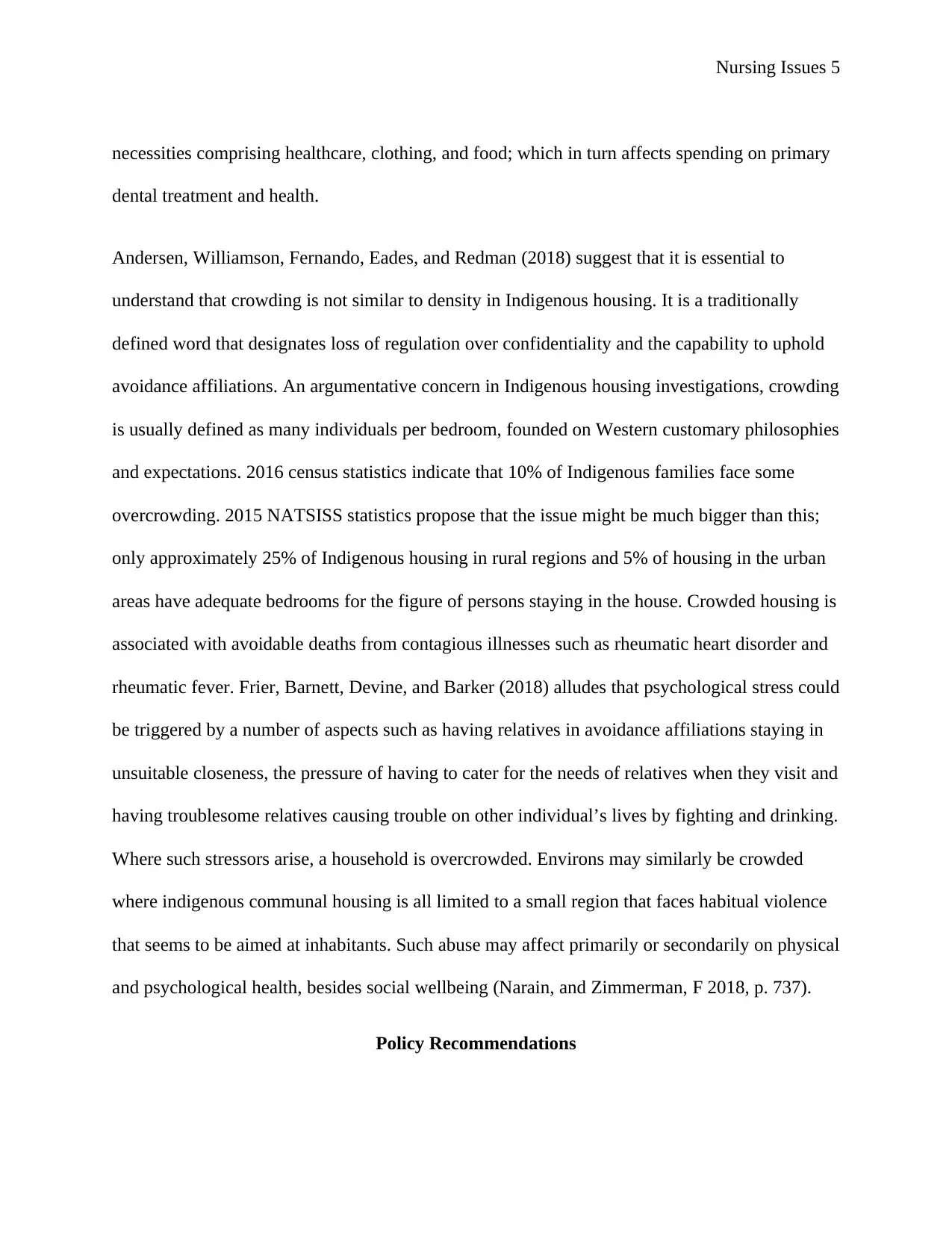
Nursing Issues 5
necessities comprising healthcare, clothing, and food; which in turn affects spending on primary
dental treatment and health.
Andersen, Williamson, Fernando, Eades, and Redman (2018) suggest that it is essential to
understand that crowding is not similar to density in Indigenous housing. It is a traditionally
defined word that designates loss of regulation over confidentiality and the capability to uphold
avoidance affiliations. An argumentative concern in Indigenous housing investigations, crowding
is usually defined as many individuals per bedroom, founded on Western customary philosophies
and expectations. 2016 census statistics indicate that 10% of Indigenous families face some
overcrowding. 2015 NATSISS statistics propose that the issue might be much bigger than this;
only approximately 25% of Indigenous housing in rural regions and 5% of housing in the urban
areas have adequate bedrooms for the figure of persons staying in the house. Crowded housing is
associated with avoidable deaths from contagious illnesses such as rheumatic heart disorder and
rheumatic fever. Frier, Barnett, Devine, and Barker (2018) alludes that psychological stress could
be triggered by a number of aspects such as having relatives in avoidance affiliations staying in
unsuitable closeness, the pressure of having to cater for the needs of relatives when they visit and
having troublesome relatives causing trouble on other individual’s lives by fighting and drinking.
Where such stressors arise, a household is overcrowded. Environs may similarly be crowded
where indigenous communal housing is all limited to a small region that faces habitual violence
that seems to be aimed at inhabitants. Such abuse may affect primarily or secondarily on physical
and psychological health, besides social wellbeing (Narain, and Zimmerman, F 2018, p. 737).
Policy Recommendations
necessities comprising healthcare, clothing, and food; which in turn affects spending on primary
dental treatment and health.
Andersen, Williamson, Fernando, Eades, and Redman (2018) suggest that it is essential to
understand that crowding is not similar to density in Indigenous housing. It is a traditionally
defined word that designates loss of regulation over confidentiality and the capability to uphold
avoidance affiliations. An argumentative concern in Indigenous housing investigations, crowding
is usually defined as many individuals per bedroom, founded on Western customary philosophies
and expectations. 2016 census statistics indicate that 10% of Indigenous families face some
overcrowding. 2015 NATSISS statistics propose that the issue might be much bigger than this;
only approximately 25% of Indigenous housing in rural regions and 5% of housing in the urban
areas have adequate bedrooms for the figure of persons staying in the house. Crowded housing is
associated with avoidable deaths from contagious illnesses such as rheumatic heart disorder and
rheumatic fever. Frier, Barnett, Devine, and Barker (2018) alludes that psychological stress could
be triggered by a number of aspects such as having relatives in avoidance affiliations staying in
unsuitable closeness, the pressure of having to cater for the needs of relatives when they visit and
having troublesome relatives causing trouble on other individual’s lives by fighting and drinking.
Where such stressors arise, a household is overcrowded. Environs may similarly be crowded
where indigenous communal housing is all limited to a small region that faces habitual violence
that seems to be aimed at inhabitants. Such abuse may affect primarily or secondarily on physical
and psychological health, besides social wellbeing (Narain, and Zimmerman, F 2018, p. 737).
Policy Recommendations
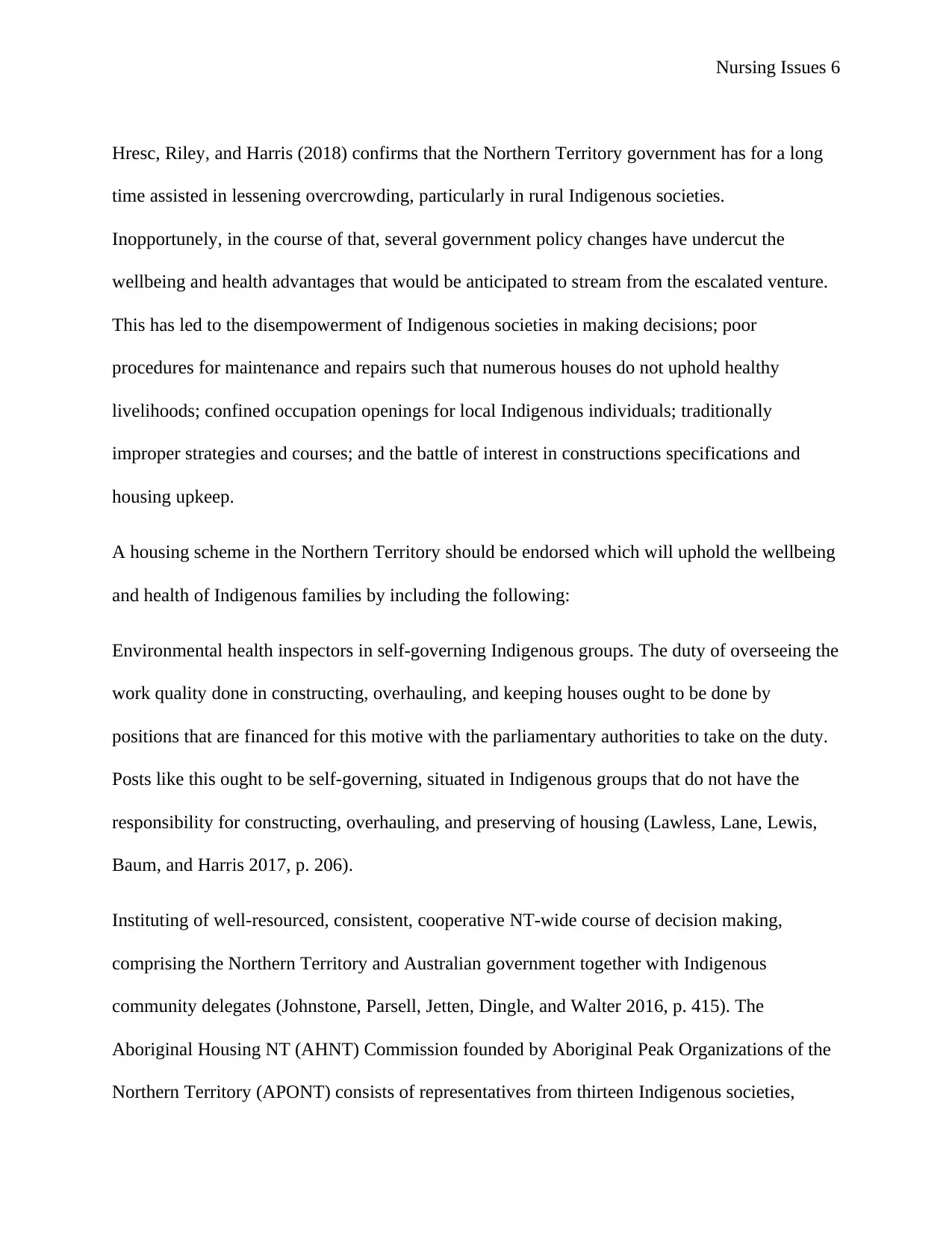
Nursing Issues 6
Hresc, Riley, and Harris (2018) confirms that the Northern Territory government has for a long
time assisted in lessening overcrowding, particularly in rural Indigenous societies.
Inopportunely, in the course of that, several government policy changes have undercut the
wellbeing and health advantages that would be anticipated to stream from the escalated venture.
This has led to the disempowerment of Indigenous societies in making decisions; poor
procedures for maintenance and repairs such that numerous houses do not uphold healthy
livelihoods; confined occupation openings for local Indigenous individuals; traditionally
improper strategies and courses; and the battle of interest in constructions specifications and
housing upkeep.
A housing scheme in the Northern Territory should be endorsed which will uphold the wellbeing
and health of Indigenous families by including the following:
Environmental health inspectors in self-governing Indigenous groups. The duty of overseeing the
work quality done in constructing, overhauling, and keeping houses ought to be done by
positions that are financed for this motive with the parliamentary authorities to take on the duty.
Posts like this ought to be self-governing, situated in Indigenous groups that do not have the
responsibility for constructing, overhauling, and preserving of housing (Lawless, Lane, Lewis,
Baum, and Harris 2017, p. 206).
Instituting of well-resourced, consistent, cooperative NT-wide course of decision making,
comprising the Northern Territory and Australian government together with Indigenous
community delegates (Johnstone, Parsell, Jetten, Dingle, and Walter 2016, p. 415). The
Aboriginal Housing NT (AHNT) Commission founded by Aboriginal Peak Organizations of the
Northern Territory (APONT) consists of representatives from thirteen Indigenous societies,
Hresc, Riley, and Harris (2018) confirms that the Northern Territory government has for a long
time assisted in lessening overcrowding, particularly in rural Indigenous societies.
Inopportunely, in the course of that, several government policy changes have undercut the
wellbeing and health advantages that would be anticipated to stream from the escalated venture.
This has led to the disempowerment of Indigenous societies in making decisions; poor
procedures for maintenance and repairs such that numerous houses do not uphold healthy
livelihoods; confined occupation openings for local Indigenous individuals; traditionally
improper strategies and courses; and the battle of interest in constructions specifications and
housing upkeep.
A housing scheme in the Northern Territory should be endorsed which will uphold the wellbeing
and health of Indigenous families by including the following:
Environmental health inspectors in self-governing Indigenous groups. The duty of overseeing the
work quality done in constructing, overhauling, and keeping houses ought to be done by
positions that are financed for this motive with the parliamentary authorities to take on the duty.
Posts like this ought to be self-governing, situated in Indigenous groups that do not have the
responsibility for constructing, overhauling, and preserving of housing (Lawless, Lane, Lewis,
Baum, and Harris 2017, p. 206).
Instituting of well-resourced, consistent, cooperative NT-wide course of decision making,
comprising the Northern Territory and Australian government together with Indigenous
community delegates (Johnstone, Parsell, Jetten, Dingle, and Walter 2016, p. 415). The
Aboriginal Housing NT (AHNT) Commission founded by Aboriginal Peak Organizations of the
Northern Territory (APONT) consists of representatives from thirteen Indigenous societies,
⊘ This is a preview!⊘
Do you want full access?
Subscribe today to unlock all pages.

Trusted by 1+ million students worldwide
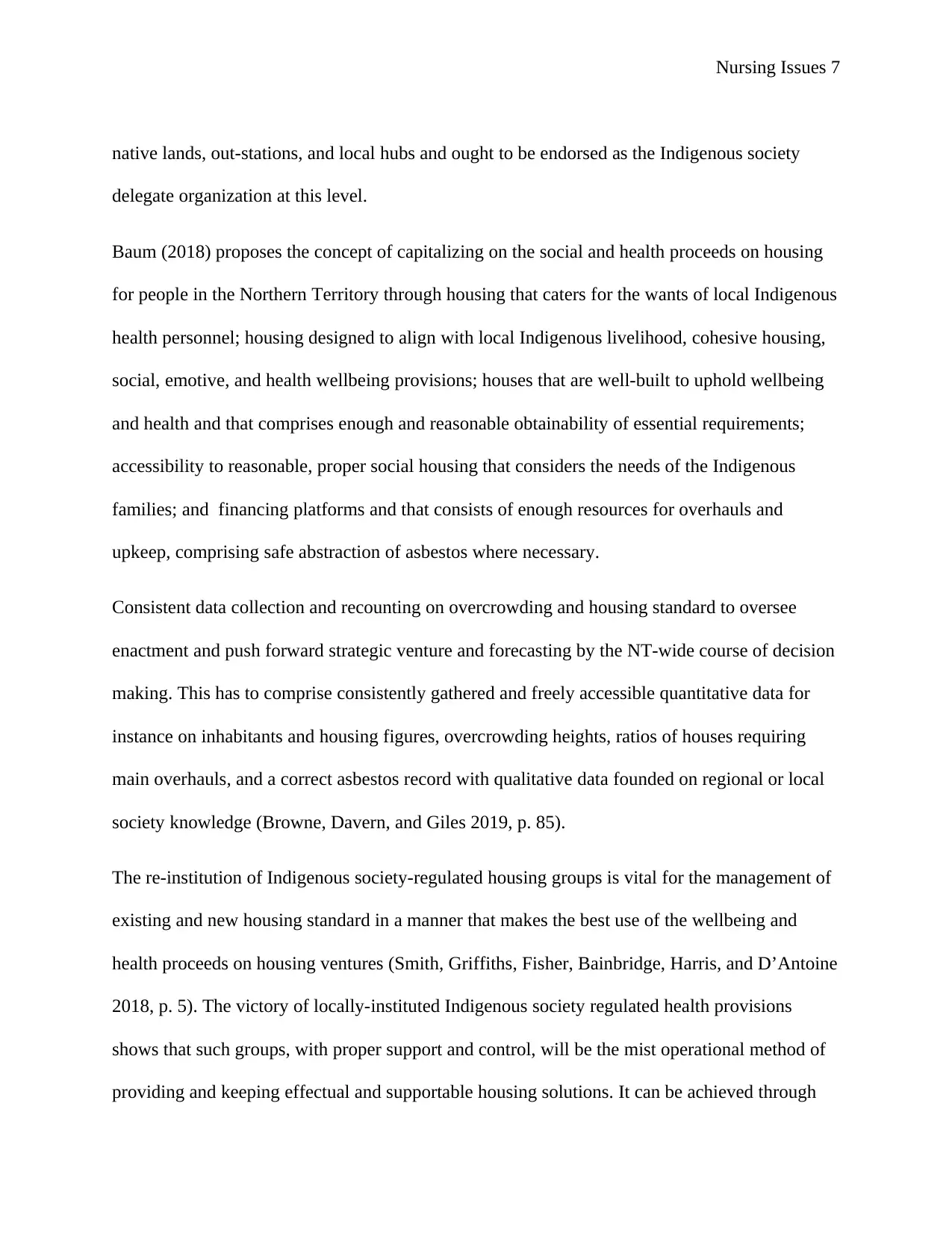
Nursing Issues 7
native lands, out-stations, and local hubs and ought to be endorsed as the Indigenous society
delegate organization at this level.
Baum (2018) proposes the concept of capitalizing on the social and health proceeds on housing
for people in the Northern Territory through housing that caters for the wants of local Indigenous
health personnel; housing designed to align with local Indigenous livelihood, cohesive housing,
social, emotive, and health wellbeing provisions; houses that are well-built to uphold wellbeing
and health and that comprises enough and reasonable obtainability of essential requirements;
accessibility to reasonable, proper social housing that considers the needs of the Indigenous
families; and financing platforms and that consists of enough resources for overhauls and
upkeep, comprising safe abstraction of asbestos where necessary.
Consistent data collection and recounting on overcrowding and housing standard to oversee
enactment and push forward strategic venture and forecasting by the NT-wide course of decision
making. This has to comprise consistently gathered and freely accessible quantitative data for
instance on inhabitants and housing figures, overcrowding heights, ratios of houses requiring
main overhauls, and a correct asbestos record with qualitative data founded on regional or local
society knowledge (Browne, Davern, and Giles 2019, p. 85).
The re-institution of Indigenous society-regulated housing groups is vital for the management of
existing and new housing standard in a manner that makes the best use of the wellbeing and
health proceeds on housing ventures (Smith, Griffiths, Fisher, Bainbridge, Harris, and D’Antoine
2018, p. 5). The victory of locally-instituted Indigenous society regulated health provisions
shows that such groups, with proper support and control, will be the mist operational method of
providing and keeping effectual and supportable housing solutions. It can be achieved through
native lands, out-stations, and local hubs and ought to be endorsed as the Indigenous society
delegate organization at this level.
Baum (2018) proposes the concept of capitalizing on the social and health proceeds on housing
for people in the Northern Territory through housing that caters for the wants of local Indigenous
health personnel; housing designed to align with local Indigenous livelihood, cohesive housing,
social, emotive, and health wellbeing provisions; houses that are well-built to uphold wellbeing
and health and that comprises enough and reasonable obtainability of essential requirements;
accessibility to reasonable, proper social housing that considers the needs of the Indigenous
families; and financing platforms and that consists of enough resources for overhauls and
upkeep, comprising safe abstraction of asbestos where necessary.
Consistent data collection and recounting on overcrowding and housing standard to oversee
enactment and push forward strategic venture and forecasting by the NT-wide course of decision
making. This has to comprise consistently gathered and freely accessible quantitative data for
instance on inhabitants and housing figures, overcrowding heights, ratios of houses requiring
main overhauls, and a correct asbestos record with qualitative data founded on regional or local
society knowledge (Browne, Davern, and Giles 2019, p. 85).
The re-institution of Indigenous society-regulated housing groups is vital for the management of
existing and new housing standard in a manner that makes the best use of the wellbeing and
health proceeds on housing ventures (Smith, Griffiths, Fisher, Bainbridge, Harris, and D’Antoine
2018, p. 5). The victory of locally-instituted Indigenous society regulated health provisions
shows that such groups, with proper support and control, will be the mist operational method of
providing and keeping effectual and supportable housing solutions. It can be achieved through
Paraphrase This Document
Need a fresh take? Get an instant paraphrase of this document with our AI Paraphraser
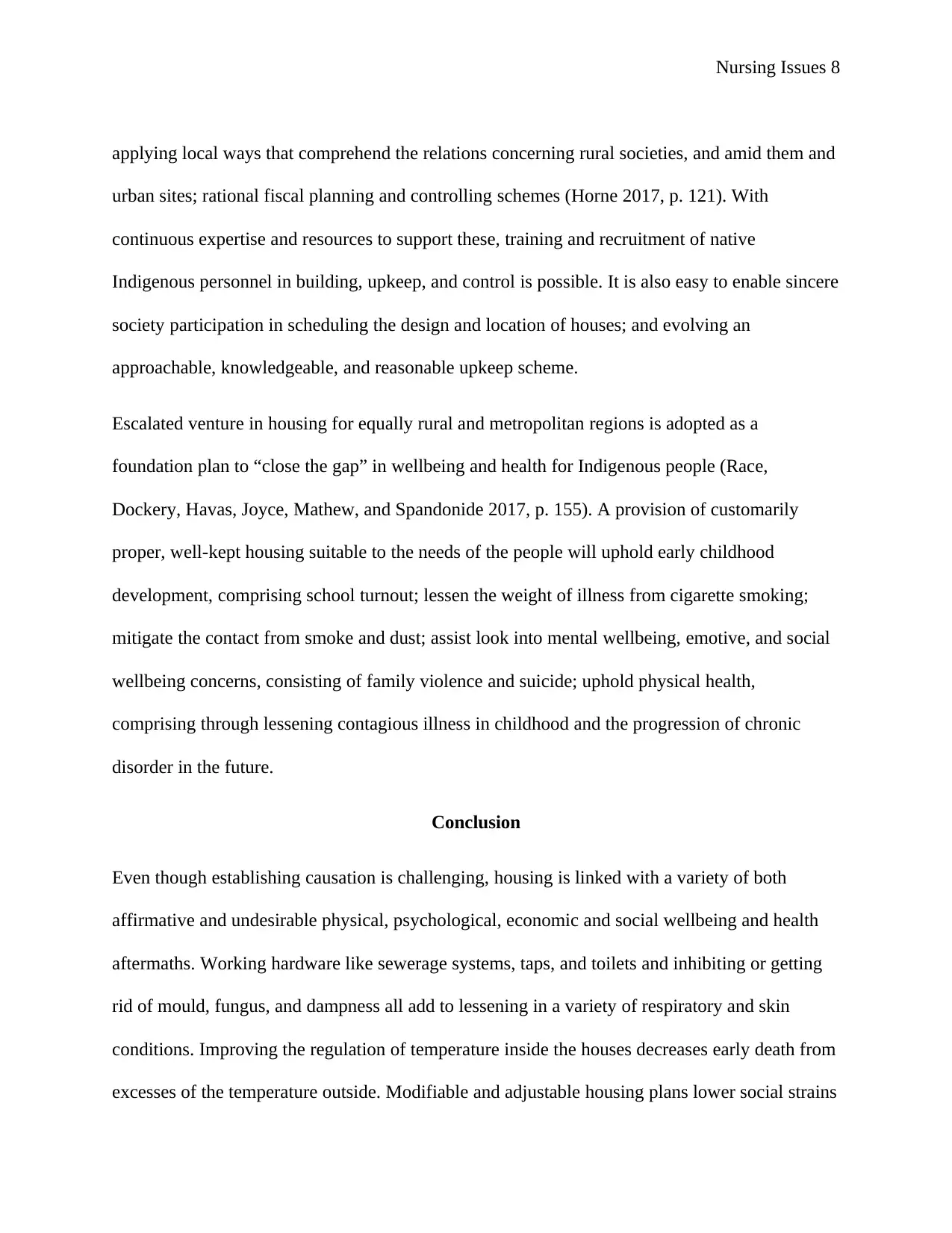
Nursing Issues 8
applying local ways that comprehend the relations concerning rural societies, and amid them and
urban sites; rational fiscal planning and controlling schemes (Horne 2017, p. 121). With
continuous expertise and resources to support these, training and recruitment of native
Indigenous personnel in building, upkeep, and control is possible. It is also easy to enable sincere
society participation in scheduling the design and location of houses; and evolving an
approachable, knowledgeable, and reasonable upkeep scheme.
Escalated venture in housing for equally rural and metropolitan regions is adopted as a
foundation plan to “close the gap” in wellbeing and health for Indigenous people (Race,
Dockery, Havas, Joyce, Mathew, and Spandonide 2017, p. 155). A provision of customarily
proper, well-kept housing suitable to the needs of the people will uphold early childhood
development, comprising school turnout; lessen the weight of illness from cigarette smoking;
mitigate the contact from smoke and dust; assist look into mental wellbeing, emotive, and social
wellbeing concerns, consisting of family violence and suicide; uphold physical health,
comprising through lessening contagious illness in childhood and the progression of chronic
disorder in the future.
Conclusion
Even though establishing causation is challenging, housing is linked with a variety of both
affirmative and undesirable physical, psychological, economic and social wellbeing and health
aftermaths. Working hardware like sewerage systems, taps, and toilets and inhibiting or getting
rid of mould, fungus, and dampness all add to lessening in a variety of respiratory and skin
conditions. Improving the regulation of temperature inside the houses decreases early death from
excesses of the temperature outside. Modifiable and adjustable housing plans lower social strains
applying local ways that comprehend the relations concerning rural societies, and amid them and
urban sites; rational fiscal planning and controlling schemes (Horne 2017, p. 121). With
continuous expertise and resources to support these, training and recruitment of native
Indigenous personnel in building, upkeep, and control is possible. It is also easy to enable sincere
society participation in scheduling the design and location of houses; and evolving an
approachable, knowledgeable, and reasonable upkeep scheme.
Escalated venture in housing for equally rural and metropolitan regions is adopted as a
foundation plan to “close the gap” in wellbeing and health for Indigenous people (Race,
Dockery, Havas, Joyce, Mathew, and Spandonide 2017, p. 155). A provision of customarily
proper, well-kept housing suitable to the needs of the people will uphold early childhood
development, comprising school turnout; lessen the weight of illness from cigarette smoking;
mitigate the contact from smoke and dust; assist look into mental wellbeing, emotive, and social
wellbeing concerns, consisting of family violence and suicide; uphold physical health,
comprising through lessening contagious illness in childhood and the progression of chronic
disorder in the future.
Conclusion
Even though establishing causation is challenging, housing is linked with a variety of both
affirmative and undesirable physical, psychological, economic and social wellbeing and health
aftermaths. Working hardware like sewerage systems, taps, and toilets and inhibiting or getting
rid of mould, fungus, and dampness all add to lessening in a variety of respiratory and skin
conditions. Improving the regulation of temperature inside the houses decreases early death from
excesses of the temperature outside. Modifiable and adjustable housing plans lower social strains
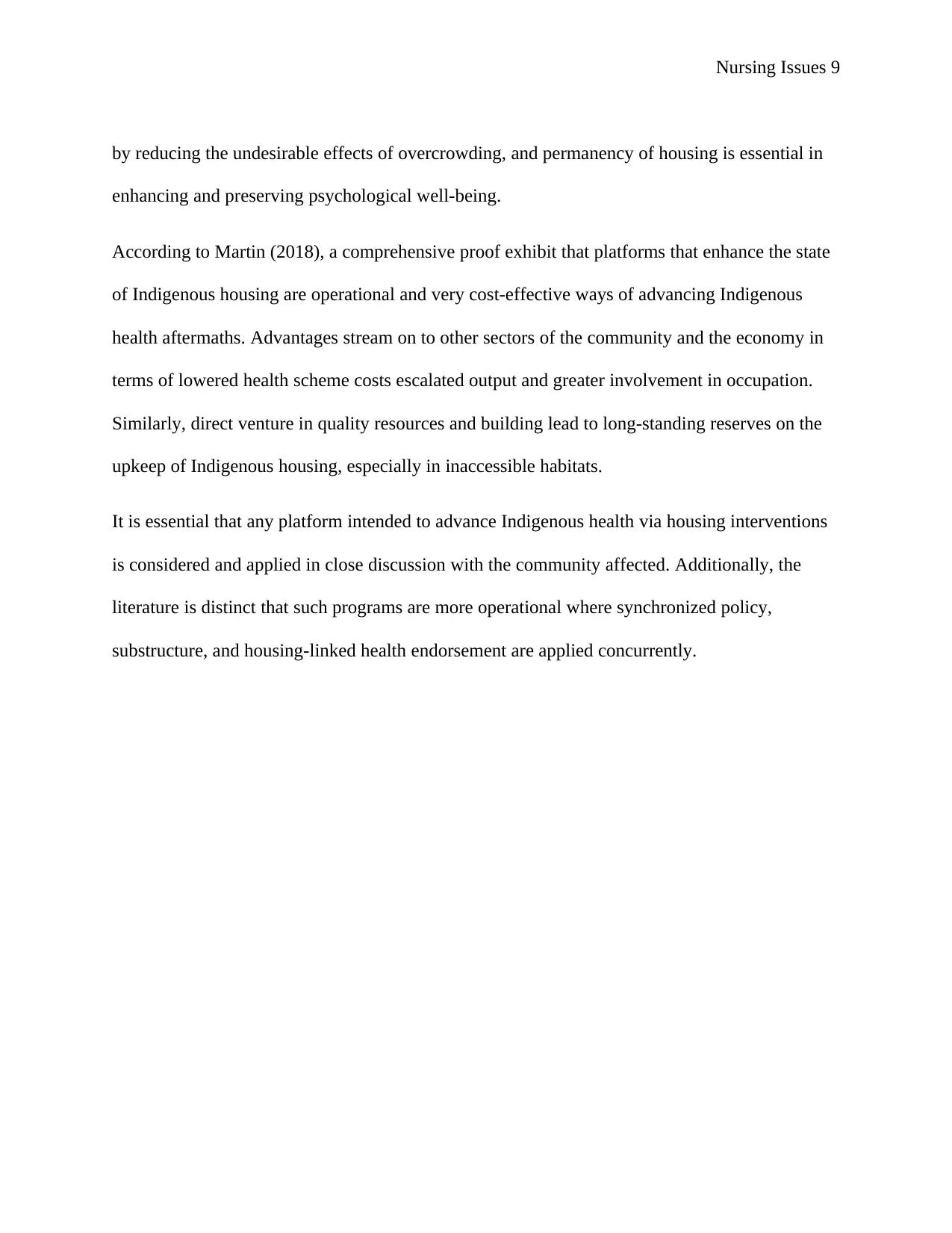
Nursing Issues 9
by reducing the undesirable effects of overcrowding, and permanency of housing is essential in
enhancing and preserving psychological well-being.
According to Martin (2018), a comprehensive proof exhibit that platforms that enhance the state
of Indigenous housing are operational and very cost-effective ways of advancing Indigenous
health aftermaths. Advantages stream on to other sectors of the community and the economy in
terms of lowered health scheme costs escalated output and greater involvement in occupation.
Similarly, direct venture in quality resources and building lead to long-standing reserves on the
upkeep of Indigenous housing, especially in inaccessible habitats.
It is essential that any platform intended to advance Indigenous health via housing interventions
is considered and applied in close discussion with the community affected. Additionally, the
literature is distinct that such programs are more operational where synchronized policy,
substructure, and housing-linked health endorsement are applied concurrently.
by reducing the undesirable effects of overcrowding, and permanency of housing is essential in
enhancing and preserving psychological well-being.
According to Martin (2018), a comprehensive proof exhibit that platforms that enhance the state
of Indigenous housing are operational and very cost-effective ways of advancing Indigenous
health aftermaths. Advantages stream on to other sectors of the community and the economy in
terms of lowered health scheme costs escalated output and greater involvement in occupation.
Similarly, direct venture in quality resources and building lead to long-standing reserves on the
upkeep of Indigenous housing, especially in inaccessible habitats.
It is essential that any platform intended to advance Indigenous health via housing interventions
is considered and applied in close discussion with the community affected. Additionally, the
literature is distinct that such programs are more operational where synchronized policy,
substructure, and housing-linked health endorsement are applied concurrently.
⊘ This is a preview!⊘
Do you want full access?
Subscribe today to unlock all pages.

Trusted by 1+ million students worldwide
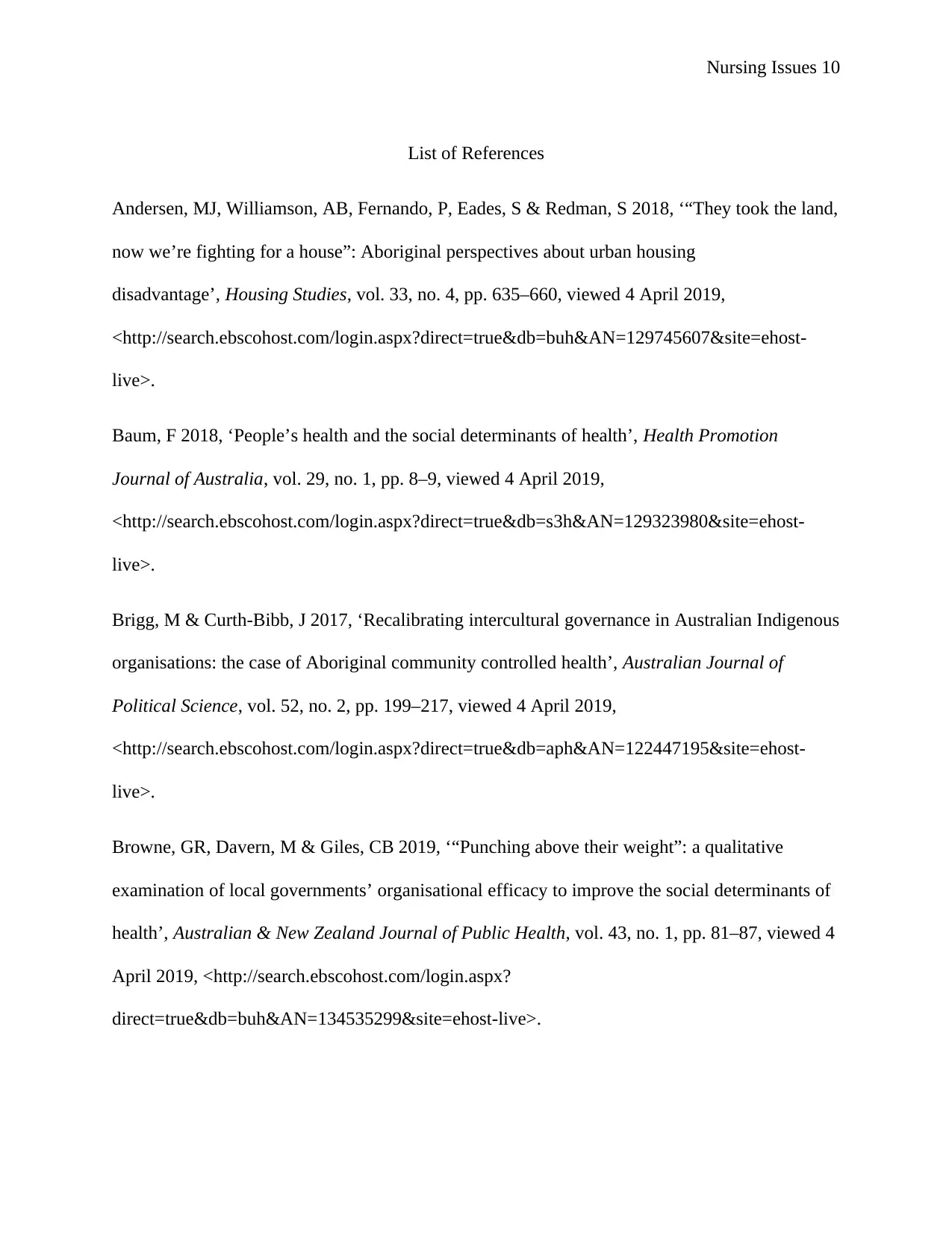
Nursing Issues 10
List of References
Andersen, MJ, Williamson, AB, Fernando, P, Eades, S & Redman, S 2018, ‘“They took the land,
now we’re fighting for a house”: Aboriginal perspectives about urban housing
disadvantage’, Housing Studies, vol. 33, no. 4, pp. 635–660, viewed 4 April 2019,
<http://search.ebscohost.com/login.aspx?direct=true&db=buh&AN=129745607&site=ehost-
live>.
Baum, F 2018, ‘People’s health and the social determinants of health’, Health Promotion
Journal of Australia, vol. 29, no. 1, pp. 8–9, viewed 4 April 2019,
<http://search.ebscohost.com/login.aspx?direct=true&db=s3h&AN=129323980&site=ehost-
live>.
Brigg, M & Curth-Bibb, J 2017, ‘Recalibrating intercultural governance in Australian Indigenous
organisations: the case of Aboriginal community controlled health’, Australian Journal of
Political Science, vol. 52, no. 2, pp. 199–217, viewed 4 April 2019,
<http://search.ebscohost.com/login.aspx?direct=true&db=aph&AN=122447195&site=ehost-
live>.
Browne, GR, Davern, M & Giles, CB 2019, ‘“Punching above their weight”: a qualitative
examination of local governments’ organisational efficacy to improve the social determinants of
health’, Australian & New Zealand Journal of Public Health, vol. 43, no. 1, pp. 81–87, viewed 4
April 2019, <http://search.ebscohost.com/login.aspx?
direct=true&db=buh&AN=134535299&site=ehost-live>.
List of References
Andersen, MJ, Williamson, AB, Fernando, P, Eades, S & Redman, S 2018, ‘“They took the land,
now we’re fighting for a house”: Aboriginal perspectives about urban housing
disadvantage’, Housing Studies, vol. 33, no. 4, pp. 635–660, viewed 4 April 2019,
<http://search.ebscohost.com/login.aspx?direct=true&db=buh&AN=129745607&site=ehost-
live>.
Baum, F 2018, ‘People’s health and the social determinants of health’, Health Promotion
Journal of Australia, vol. 29, no. 1, pp. 8–9, viewed 4 April 2019,
<http://search.ebscohost.com/login.aspx?direct=true&db=s3h&AN=129323980&site=ehost-
live>.
Brigg, M & Curth-Bibb, J 2017, ‘Recalibrating intercultural governance in Australian Indigenous
organisations: the case of Aboriginal community controlled health’, Australian Journal of
Political Science, vol. 52, no. 2, pp. 199–217, viewed 4 April 2019,
<http://search.ebscohost.com/login.aspx?direct=true&db=aph&AN=122447195&site=ehost-
live>.
Browne, GR, Davern, M & Giles, CB 2019, ‘“Punching above their weight”: a qualitative
examination of local governments’ organisational efficacy to improve the social determinants of
health’, Australian & New Zealand Journal of Public Health, vol. 43, no. 1, pp. 81–87, viewed 4
April 2019, <http://search.ebscohost.com/login.aspx?
direct=true&db=buh&AN=134535299&site=ehost-live>.
Paraphrase This Document
Need a fresh take? Get an instant paraphrase of this document with our AI Paraphraser
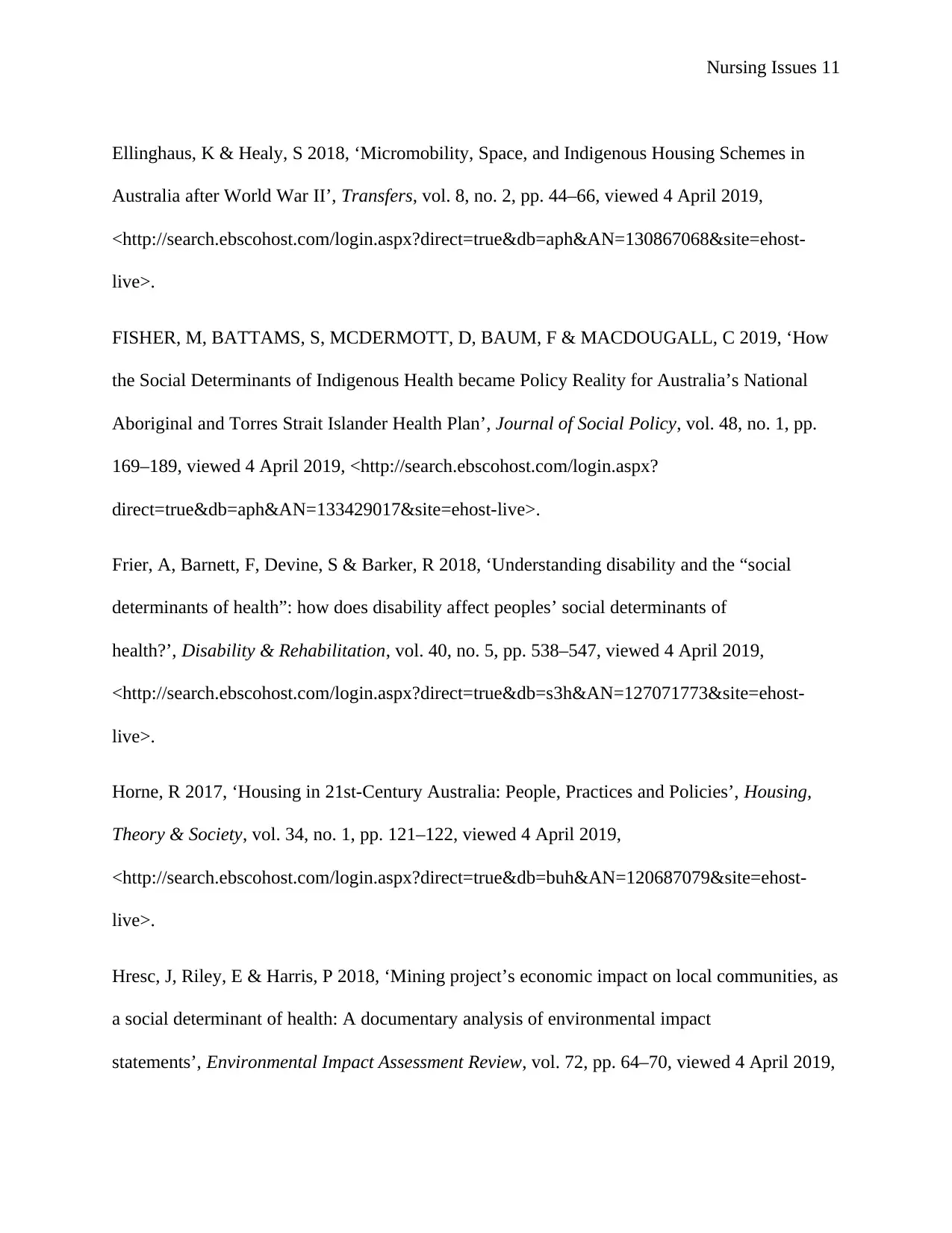
Nursing Issues 11
Ellinghaus, K & Healy, S 2018, ‘Micromobility, Space, and Indigenous Housing Schemes in
Australia after World War II’, Transfers, vol. 8, no. 2, pp. 44–66, viewed 4 April 2019,
<http://search.ebscohost.com/login.aspx?direct=true&db=aph&AN=130867068&site=ehost-
live>.
FISHER, M, BATTAMS, S, MCDERMOTT, D, BAUM, F & MACDOUGALL, C 2019, ‘How
the Social Determinants of Indigenous Health became Policy Reality for Australia’s National
Aboriginal and Torres Strait Islander Health Plan’, Journal of Social Policy, vol. 48, no. 1, pp.
169–189, viewed 4 April 2019, <http://search.ebscohost.com/login.aspx?
direct=true&db=aph&AN=133429017&site=ehost-live>.
Frier, A, Barnett, F, Devine, S & Barker, R 2018, ‘Understanding disability and the “social
determinants of health”: how does disability affect peoples’ social determinants of
health?’, Disability & Rehabilitation, vol. 40, no. 5, pp. 538–547, viewed 4 April 2019,
<http://search.ebscohost.com/login.aspx?direct=true&db=s3h&AN=127071773&site=ehost-
live>.
Horne, R 2017, ‘Housing in 21st-Century Australia: People, Practices and Policies’, Housing,
Theory & Society, vol. 34, no. 1, pp. 121–122, viewed 4 April 2019,
<http://search.ebscohost.com/login.aspx?direct=true&db=buh&AN=120687079&site=ehost-
live>.
Hresc, J, Riley, E & Harris, P 2018, ‘Mining project’s economic impact on local communities, as
a social determinant of health: A documentary analysis of environmental impact
statements’, Environmental Impact Assessment Review, vol. 72, pp. 64–70, viewed 4 April 2019,
Ellinghaus, K & Healy, S 2018, ‘Micromobility, Space, and Indigenous Housing Schemes in
Australia after World War II’, Transfers, vol. 8, no. 2, pp. 44–66, viewed 4 April 2019,
<http://search.ebscohost.com/login.aspx?direct=true&db=aph&AN=130867068&site=ehost-
live>.
FISHER, M, BATTAMS, S, MCDERMOTT, D, BAUM, F & MACDOUGALL, C 2019, ‘How
the Social Determinants of Indigenous Health became Policy Reality for Australia’s National
Aboriginal and Torres Strait Islander Health Plan’, Journal of Social Policy, vol. 48, no. 1, pp.
169–189, viewed 4 April 2019, <http://search.ebscohost.com/login.aspx?
direct=true&db=aph&AN=133429017&site=ehost-live>.
Frier, A, Barnett, F, Devine, S & Barker, R 2018, ‘Understanding disability and the “social
determinants of health”: how does disability affect peoples’ social determinants of
health?’, Disability & Rehabilitation, vol. 40, no. 5, pp. 538–547, viewed 4 April 2019,
<http://search.ebscohost.com/login.aspx?direct=true&db=s3h&AN=127071773&site=ehost-
live>.
Horne, R 2017, ‘Housing in 21st-Century Australia: People, Practices and Policies’, Housing,
Theory & Society, vol. 34, no. 1, pp. 121–122, viewed 4 April 2019,
<http://search.ebscohost.com/login.aspx?direct=true&db=buh&AN=120687079&site=ehost-
live>.
Hresc, J, Riley, E & Harris, P 2018, ‘Mining project’s economic impact on local communities, as
a social determinant of health: A documentary analysis of environmental impact
statements’, Environmental Impact Assessment Review, vol. 72, pp. 64–70, viewed 4 April 2019,
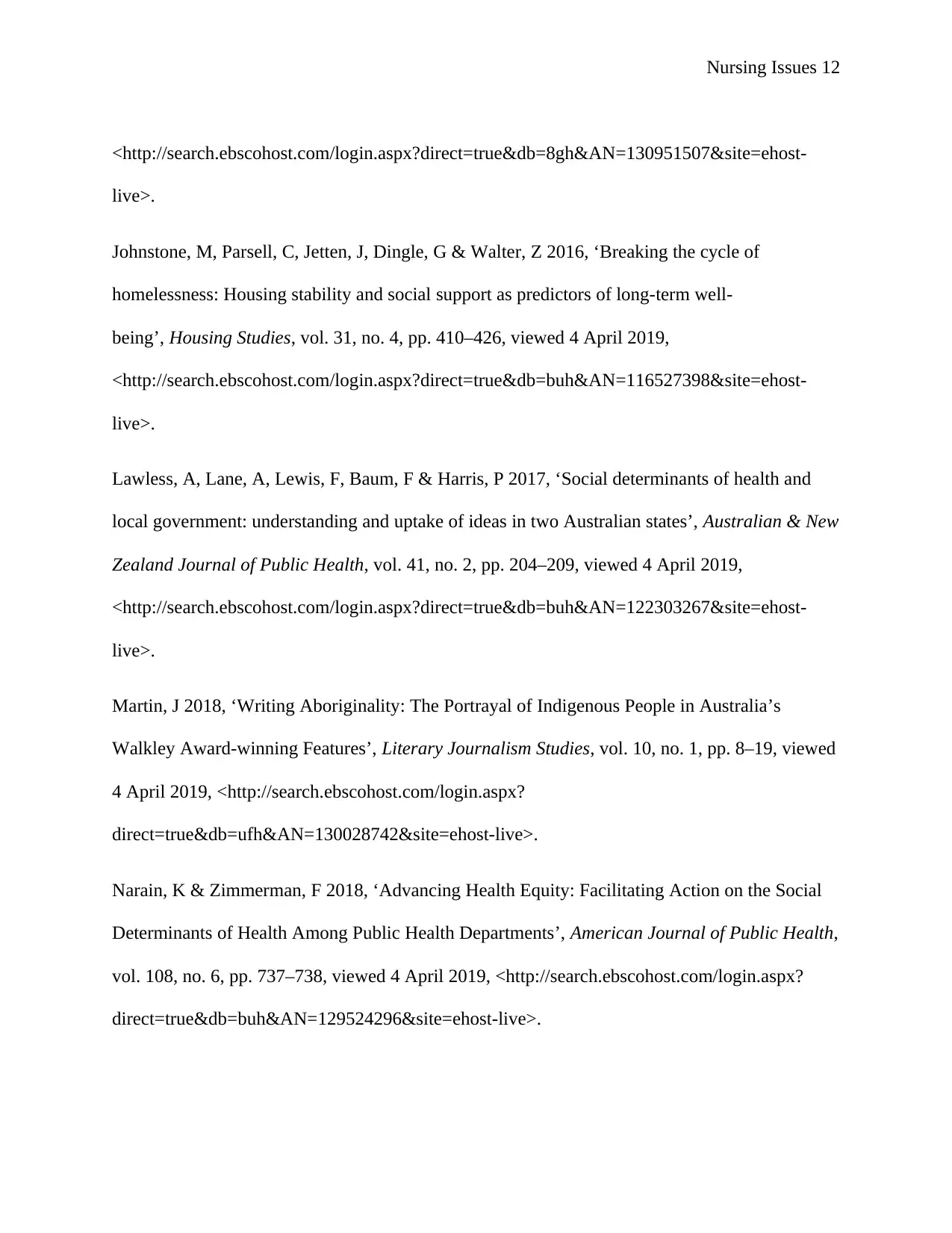
Nursing Issues 12
<http://search.ebscohost.com/login.aspx?direct=true&db=8gh&AN=130951507&site=ehost-
live>.
Johnstone, M, Parsell, C, Jetten, J, Dingle, G & Walter, Z 2016, ‘Breaking the cycle of
homelessness: Housing stability and social support as predictors of long-term well-
being’, Housing Studies, vol. 31, no. 4, pp. 410–426, viewed 4 April 2019,
<http://search.ebscohost.com/login.aspx?direct=true&db=buh&AN=116527398&site=ehost-
live>.
Lawless, A, Lane, A, Lewis, F, Baum, F & Harris, P 2017, ‘Social determinants of health and
local government: understanding and uptake of ideas in two Australian states’, Australian & New
Zealand Journal of Public Health, vol. 41, no. 2, pp. 204–209, viewed 4 April 2019,
<http://search.ebscohost.com/login.aspx?direct=true&db=buh&AN=122303267&site=ehost-
live>.
Martin, J 2018, ‘Writing Aboriginality: The Portrayal of Indigenous People in Australia’s
Walkley Award-winning Features’, Literary Journalism Studies, vol. 10, no. 1, pp. 8–19, viewed
4 April 2019, <http://search.ebscohost.com/login.aspx?
direct=true&db=ufh&AN=130028742&site=ehost-live>.
Narain, K & Zimmerman, F 2018, ‘Advancing Health Equity: Facilitating Action on the Social
Determinants of Health Among Public Health Departments’, American Journal of Public Health,
vol. 108, no. 6, pp. 737–738, viewed 4 April 2019, <http://search.ebscohost.com/login.aspx?
direct=true&db=buh&AN=129524296&site=ehost-live>.
<http://search.ebscohost.com/login.aspx?direct=true&db=8gh&AN=130951507&site=ehost-
live>.
Johnstone, M, Parsell, C, Jetten, J, Dingle, G & Walter, Z 2016, ‘Breaking the cycle of
homelessness: Housing stability and social support as predictors of long-term well-
being’, Housing Studies, vol. 31, no. 4, pp. 410–426, viewed 4 April 2019,
<http://search.ebscohost.com/login.aspx?direct=true&db=buh&AN=116527398&site=ehost-
live>.
Lawless, A, Lane, A, Lewis, F, Baum, F & Harris, P 2017, ‘Social determinants of health and
local government: understanding and uptake of ideas in two Australian states’, Australian & New
Zealand Journal of Public Health, vol. 41, no. 2, pp. 204–209, viewed 4 April 2019,
<http://search.ebscohost.com/login.aspx?direct=true&db=buh&AN=122303267&site=ehost-
live>.
Martin, J 2018, ‘Writing Aboriginality: The Portrayal of Indigenous People in Australia’s
Walkley Award-winning Features’, Literary Journalism Studies, vol. 10, no. 1, pp. 8–19, viewed
4 April 2019, <http://search.ebscohost.com/login.aspx?
direct=true&db=ufh&AN=130028742&site=ehost-live>.
Narain, K & Zimmerman, F 2018, ‘Advancing Health Equity: Facilitating Action on the Social
Determinants of Health Among Public Health Departments’, American Journal of Public Health,
vol. 108, no. 6, pp. 737–738, viewed 4 April 2019, <http://search.ebscohost.com/login.aspx?
direct=true&db=buh&AN=129524296&site=ehost-live>.
⊘ This is a preview!⊘
Do you want full access?
Subscribe today to unlock all pages.

Trusted by 1+ million students worldwide
1 out of 14
Your All-in-One AI-Powered Toolkit for Academic Success.
+13062052269
info@desklib.com
Available 24*7 on WhatsApp / Email
![[object Object]](/_next/static/media/star-bottom.7253800d.svg)
Unlock your academic potential
Copyright © 2020–2025 A2Z Services. All Rights Reserved. Developed and managed by ZUCOL.